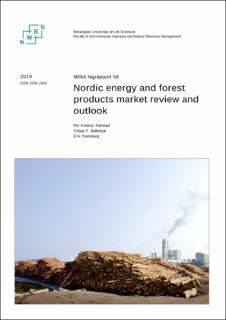| dc.description.abstract | The Nordic power market
The past has shown that some of the main power price drivers are quite unpredictable, while some major trends are quite certain. The joint Swedish – Norwegian green certificate system is well on track to reach the common goal of 28.4 TWh new renewable electricity production by 2020. The Swedish government has announced that it will prolong the green certificate system, while renewable support in Norway and Finland is uncertain after 2020. Still, wind investments are expected to continue at a fast pace beyond 2020 in the Nordic region. Although many hydropower projects have low costs, environmental restrictions in many rivers limit the potential. The main share of new hydropower will be small-scale run-of-river projects. The Swedish nuclear capacity is expected to decrease, while the capacity in Finland will increase. In total there will be a slight increase in the total nuclear power capacity toward 2030. We assume that fossil power generation will be phased out by 2030 in the Nordic countries. Despite low fossil fuel shares in the Nordic market, thermal power will continue to impact Nordic power prices through increasing exchange to/from the Continent and the UK.
Energy intensity in households has started to decline and this is expected to continue to 2040, due to new building standards. The expected growth in population in the Nordic area contributes, however, in the opposite direction. An increasing number of electric vehicles will contribute to an increase in consumption.
The Nordic countries have a large power intensive industry sector. The pulp and paper industry is currently consuming approximately 40 TWh annually. We expect a major transition of the forest industry away from paper production, contributing to a reduction in industrial consumption. A switch in the oil sector to electricity produced onshore may contribute to increasing demand. We also assume increasing demand from data centers in the Nordic region. Overall, the industry sector consumption represents the largest uncertainty in future demand.
The growth in (variable) renewable power on the Continent will make investments in interconnection capacity more attractive – due to short-term price variations. The export capacity in the Nordic region is expected to increase to 14 GW by 2030. This is about three times the current capacity. The power price is expected to increase continuously toward 2050, with the largest effect in Denmark. The uncertainty regarding future power prices is, however, substantial; with the most important aspects of uncertainties being the price of fossil fuel (gas and coal), CO2-quotas price, the share of renewable energy in the power system, the capacity margins and the development in energy storage and consumer flexibility.
Nordic heating and cooling markets
Future energy consumption in heating and cooling depends on several factors. Improved building standards and higher outdoor temperatures imply reduced heat demand whereas population growth, fewer people per households and increased cooling demand implies higher energy use for heating and cooling. The total effects are unclear and depend on policies and regulations, including future energy costs that influence the profitability of energy efficiency investments. The current changes are also relatively slow due to slow rehabilitation and replacement rates in the building sector.
The renewable share in heating and cooling is relatively low in many countries and replacement of fossil fuels with biomass represents the major potential for biomass in Europe. In the Nordic countries, replacement of fossil fuels in district heating in Denmark and Finland is important, whereas expansion of district heating is needed in Sweden and Norway as most of the existing district heating is based on renewables.
Non-energy forest products markets
Sawlog is the most important timber grade. In Norway it account for about 70% of the gross income to forest owners. The consumption, and thereby the production, is dependent on the construction activities (i.e. new houses) and the renovation of old ones. Data indicate a cyclic sawnwood sector, with roughly about 10 - 20 years cycles. The dissolution of the former Soviet Union around 1990 and the financial crisis in 2008 represents the two latest downturns in this segment. The short-term trend indicates a 3% p.a. increase in global sawnwood production. In the longer term, there is a large untapped potential in Europe in the sense that there is a large difference in per capita consumption of sawnwood across Europe. It is however not necessarily straight forward to change habits, building regulations etc, which may be needed in order to increase the use of wood in buildings.
Newsprint and other printing and writing paper is on the decline globally and in most of the market analyzed in this report. The demand for graphic paper will not vanish, but there are no indications that we will see a large increase in demand in the future. The main reason for the decline is the shift from printed to digital media. It is reasonable to believe that developing economies will jump right to digital media. The short-term decline in global newsprint production is estimated to 4.8% p.a., while the decline in printing and writing paper is estimated to be 1.0% p.a.
The products group “other paper and paperboard” comprises hygienic goods (e.g. tissue paper and disposable diapers) and packaging materials (e.g. paperboards), and the latter group is the dominant one. Except for the Americas where the production has been stable after the mid 90-ies, there has been increases in production in both Asia and Europe. Internet trade is probably the most important driver in the near past. The main drivers for hygienic products are economic development and age structure of the population. In the short term, we estimate the yearly increase to 3.0%.
Societal demands for mitigation and adaptation to climate change will have implications for the forest sector. EU energy and environmental policies have the potential to advance a paradigm change towards a forest-based bioeconomy. This could mean the production of a wide array of (chemical) products like textile fibers (viscose) or construction materials like cross-laminated timber. | en_US |

